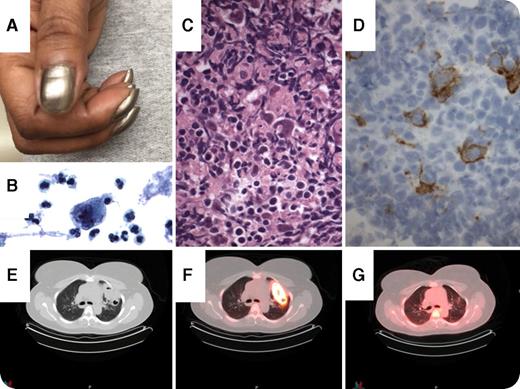A 43-year-old woman with tobacco use and asthma was admitted to the hospital for dyspnea, productive cough, and fever. A computed tomography (CT) scan of her chest showed a large cavitary mass concerning for lung abscess or malignancy. On physical examination, the patient was found to have digital clubbing of her hands (panel A) and a single enlarged left supraclavicular lymph node. Sputum cytology revealed a Reed-Sternberg cell (panel B; original magnification ×60, Pap stain). Diagnosis of Hodgkin lymphoma was confirmed on biopsy of the enlarged supraclavicular lymph node with morphology (panel C; original magnification ×60, hematoxylin and eosin stain) and CD30 staining (panel D; original magnification ×60, mouse antihuman CD30 monoclonal antibody stain). A subsequent positron emission tomography (PET)/CT scan showed the cavitary lung lesion (panel E) to be intensely fludeoxyglucose avid (panel F). Based on the above, the patient was diagnosed with Hodgkin lymphoma presenting with a cavitary lung mass. Following 2 cycles of doxorubicin (Adriamycin)-bleomycin-vinblastine-dacarbazine (ABVD) chemotherapy, the patient had a repeat PET/CT scan showing resolution of her disease (panel G). She went on to receive a total of 6 cycles of ABVD for advanced-stage Hodgkin lymphoma.
Pulmonary parenchymal involvement by Hodgkin lymphoma is a rare entity confined to case reports. The clinical and radiographic presentation can be nonspecific and mimic other malignant or infectious causes. Interestingly, this patient's sputum sample provided the first indication of Hodgkin lymphoma and was later confirmed by lymph node biopsy and further imaging.
A 43-year-old woman with tobacco use and asthma was admitted to the hospital for dyspnea, productive cough, and fever. A computed tomography (CT) scan of her chest showed a large cavitary mass concerning for lung abscess or malignancy. On physical examination, the patient was found to have digital clubbing of her hands (panel A) and a single enlarged left supraclavicular lymph node. Sputum cytology revealed a Reed-Sternberg cell (panel B; original magnification ×60, Pap stain). Diagnosis of Hodgkin lymphoma was confirmed on biopsy of the enlarged supraclavicular lymph node with morphology (panel C; original magnification ×60, hematoxylin and eosin stain) and CD30 staining (panel D; original magnification ×60, mouse antihuman CD30 monoclonal antibody stain). A subsequent positron emission tomography (PET)/CT scan showed the cavitary lung lesion (panel E) to be intensely fludeoxyglucose avid (panel F). Based on the above, the patient was diagnosed with Hodgkin lymphoma presenting with a cavitary lung mass. Following 2 cycles of doxorubicin (Adriamycin)-bleomycin-vinblastine-dacarbazine (ABVD) chemotherapy, the patient had a repeat PET/CT scan showing resolution of her disease (panel G). She went on to receive a total of 6 cycles of ABVD for advanced-stage Hodgkin lymphoma.
Pulmonary parenchymal involvement by Hodgkin lymphoma is a rare entity confined to case reports. The clinical and radiographic presentation can be nonspecific and mimic other malignant or infectious causes. Interestingly, this patient's sputum sample provided the first indication of Hodgkin lymphoma and was later confirmed by lymph node biopsy and further imaging.
For additional images, visit the ASH IMAGE BANK, a reference and teaching tool that is continually updated with new atlas and case study images. For more information visit http://imagebank.hematology.org.


This feature is available to Subscribers Only
Sign In or Create an Account Close Modal